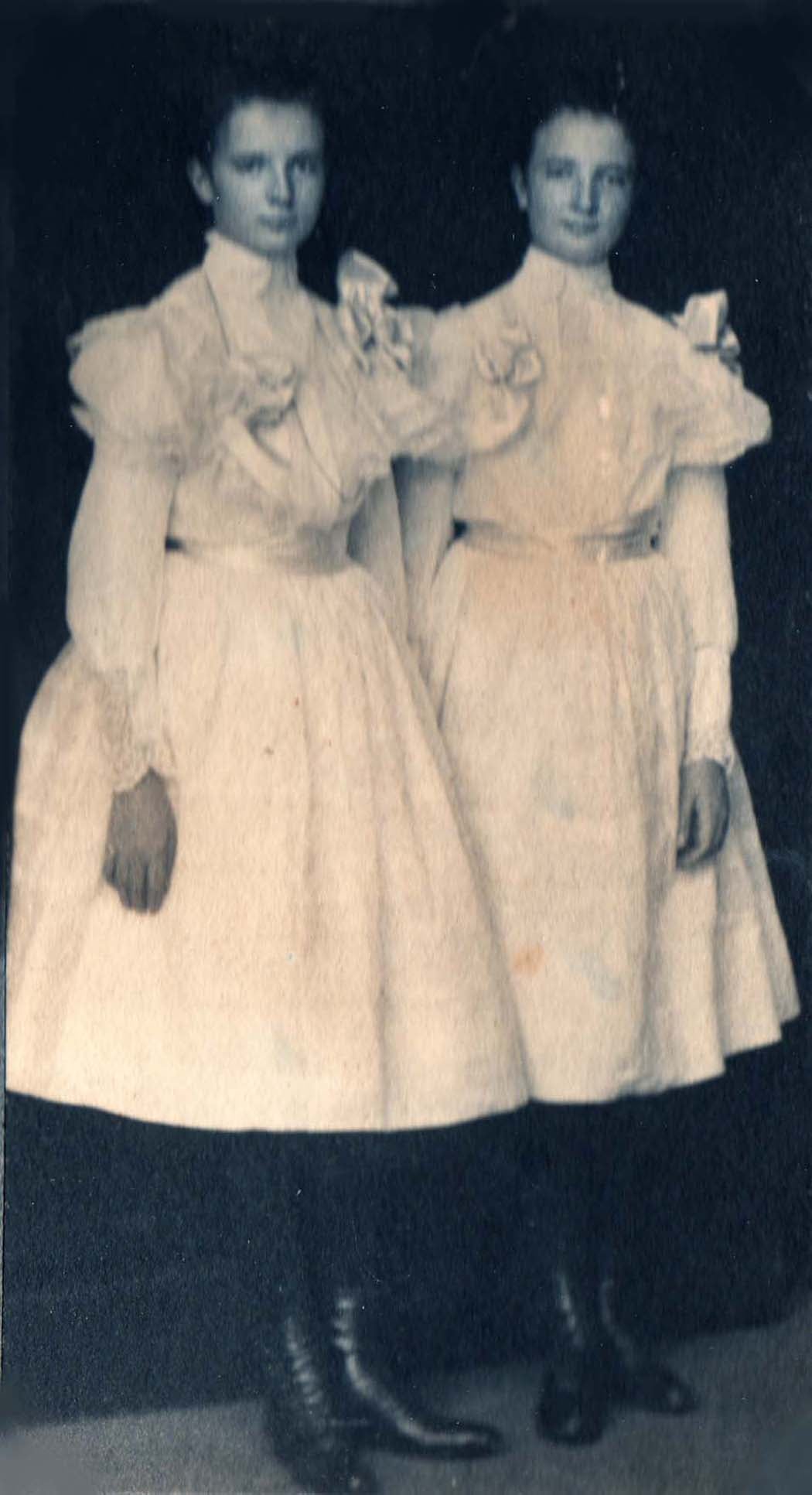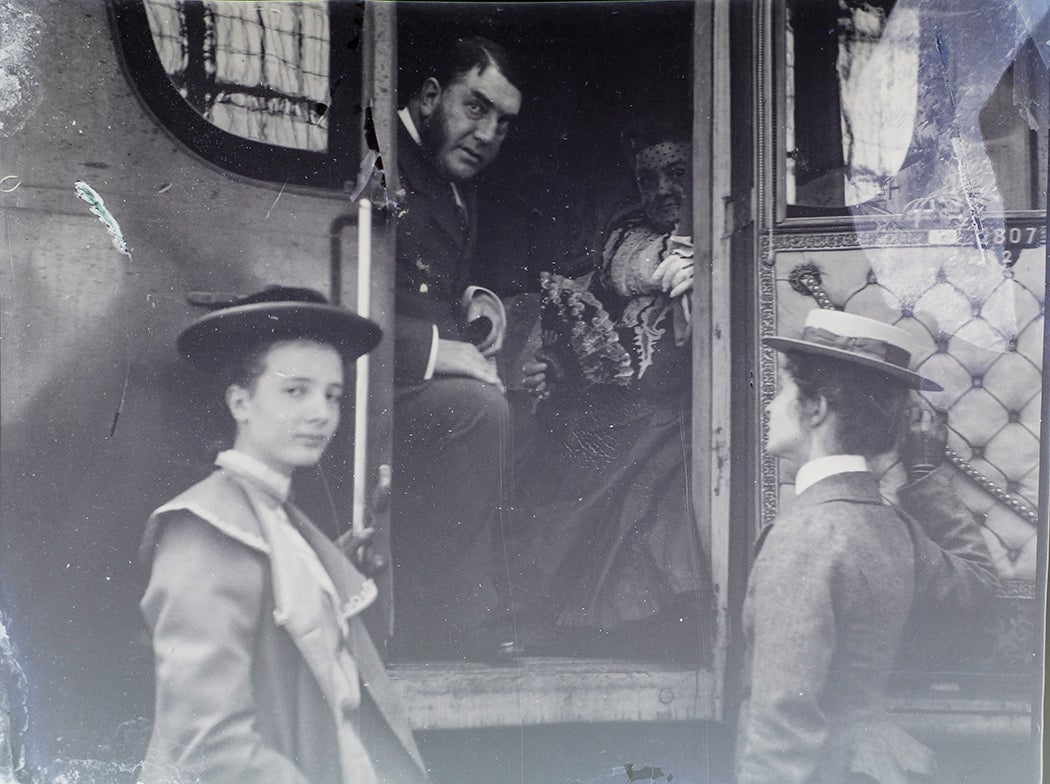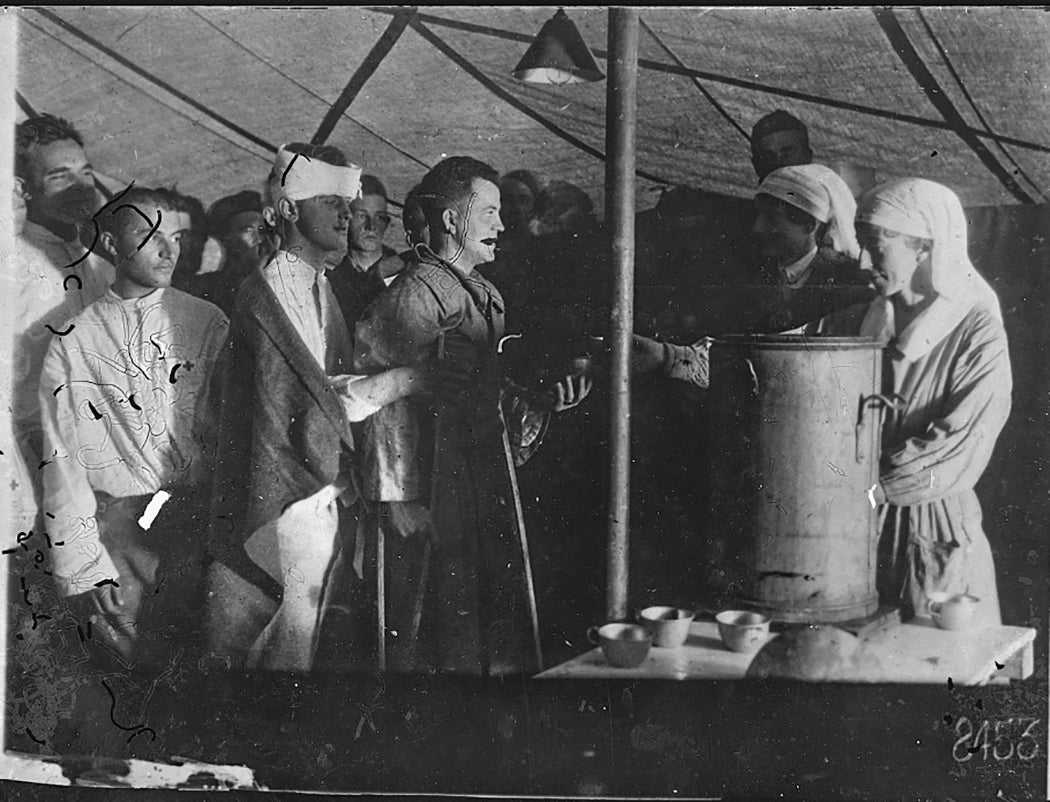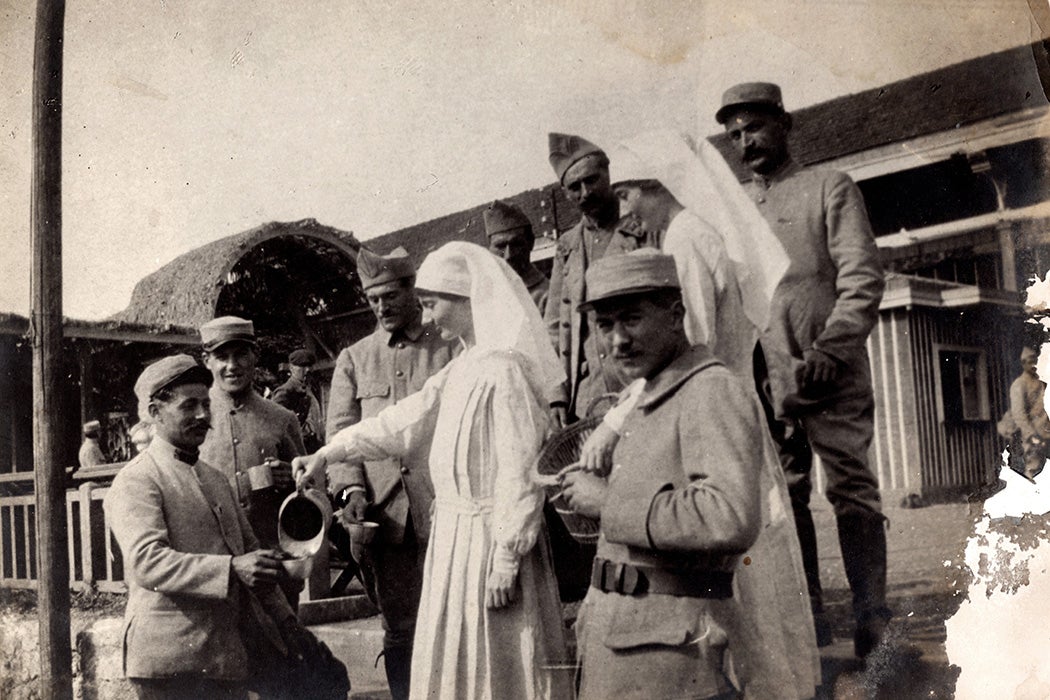The evening of January 19, 1919, was moonless, and most of the passengers aboard the SS La Lorraine were cloistered in their staterooms or dining. The Great War was over, and this ship was carrying 1,300 weary, traumatized soldiers, civilians, and American Red Cross personnel hoping to return to “ordinary” life.
As the ship sailed the Gironde River en route to the open seas, a 24-year-old US Army private noticed the outlines of two people on the otherwise cold, empty deck. The silhouetted capes identified the pair as Red Cross volunteers. The two moved toward the railing. One took a step up. And then over. A splash. Then silence. The private froze in shock. Then the other figure broke into a run. She screamed as she plummeted. There was no possibility of turning the hulking vessel around quickly enough for a rescue, and the rushing waters would have rendered any such attempts futile. Approximately 40 million people perished in World War I. Two more had now joined them. This is their story.
Weekly Newsletter
Identical twins, Dorothea Katherine and Gladys Louise Husted Cromwell were born in Brooklyn in 1886, the fourth and fifth children of middle-aged parents. Reared in the opulent wealth of upper-class society during the Gilded Age, a certain sort of cloistered existence as “society women” was expected of them. Their father was himself a scion, involved in business ventures and investments ranging from transportation to insurance and trust companies. The twins grew up sheltered in a four-story Beaux-Arts mansion in the elegant Brooklyn Heights section of the borough and, as Dorothea put it in an unpublished roman à clef, “There was a tragic possibility that they would end by counting only decoratively in the human scheme.”
Against the expectations of their family, both sisters wanted to be poets, or writers of some sort. Their interests lay amidst the world of music and the arts, and they were interested in whatever was most modern and challenging—not in the society functions and respectable marriages their parents wanted for them. Dorothea exposed precisely this dynamic in her roman à clef. In the passage below, “Mrs. Godwin” stands in for her mother, Mrs. Cromwell:
Mrs. Godwin was an imposing woman. Providence had given her wealth and a devoted husband. These luxuries lifted her above the contingencies of life, so that being free, she could afford to play with the problems of every day that to you and me are real. […]
Was it that sense, I wonder that achieved the Godwin twins? […]
She reared them not as human beings but as “ornaments,”—like a pair of polychrome candle-holders on either side of her bedroom clock. She ordered them to be frail dainty things. While they were young, Mrs. Godwin dressed then quaintly in long smocks, so that they were different from other children; they seemed to toddle more. They had straight little figures, identical profiles and wore bangs.

They were “guarded like princesses, knowing little of the world and somewhat fearful of it,” wrote Mary “Molly” Colum, a poet and literary critic who met the twins in their early adulthood.
They used to tell us of lonely days and weeping nights spent in hotels in Constantinople, Vienna, Venice, and such places. When they made their debut in New York, their beauty and strangeness had made a sensation, their brother told us; they had the high distinction that the daughters of old aristocracies are supposed to have but rarely do have. But the twins had no relish for society, and they informed the members of their family that the people they really wanted to know were writers and artists. […] When Gladys proceeded to publish her first poems and her name began to appear in magazines, the family were alarmed by what they called the “publicity.” One of them indeed expressed surprise that she had broken loose to the extent of permitting some poems with her photograph to be published in an anthology. It was hard to explain to her family the difference between budding fame and raw newspaper publicity.
Until then, Gladys had honored her parents’ desire for privacy, using the pseudonym Helen Jaffreys. It was under this name that she published “Humanity” in Harper’s at the age of 22, a poem that describes the human condition in the abstract as one of poverty, and humanity as a spiritually impoverished “weak child.” While Gladys knew nothing of material poverty, she felt a cosmic, existential impoverishment, a bafflement at the unfairness of the human condition. Why some are born to wealth and others to suffering?
In 1909, the twins’ mother died, at age 62. They were in their early 20s at the time and soon bought an apartment together on the corner of Park Avenue and East 61st Street. With their newfound freedom, they began to make connections in literary circles with the help of Mary Horgan, whom they’d first met several years earlier, when they were teenagers. Horgan had been hired in 1899 to serve as their governess. She was 25 years old and had studied at the Art Students’ League, worked as a newspaper illustrator and as an artist’s model, as an art teacher at elite finishing schools, and as a curator. The next year, she joined the Cromwells on a whirlwind tour of England and France, becoming a perfect mentor to and influence on the twins’ and their growing interest in the arts.

The end of Mary’s tenure as a governess did not end her relationship with the sisters. They were Mary’s protégées and acolytes. When she married sculptor John Mowbray-Clarke in 1907, the twins were among the few attendees at the ceremony. In 1913, Mary gave them a private tour of the Armory Show she and husband helped organize. Now famous, the show introduced American audiences to the controversial work of Pablo Picasso, Marcel Duchamp, and other members of the European avant-garde.
Three years later, Mary and a friend opened the Sunwise Turn, one of the first women-owned and operated bookshops in the US. It quickly became a gathering place for the cultural elite, over whom Mary presided. Peggy Guggenheim, a volunteer intern, called Mary “a sort of goddess to me,” and was inspired by her to begin collecting art. The Cromwells spent hours at the Sunwise Turn, absorbing talk of socialism, anarchism, feminism, and the latest cultural movements. A hub of radicalism, the Sunwise Turn carried pacifist and anti-conscription materials as well as “obscene” literary works and information on birth-control.

Above all, Gladys and Dorothea absorbed the revolutionary idealism they encountered at the Sunwise Turn. They shared a sense of responsibility to society and humanity at large, and volunteered in the war effort in ways befitting women of their station. They collected warm knits for soldiers and refugees, for instance, and helped send sugar and other scarce supplies to the Soldiers and Sailors Club in Paris.
Yet they knew there was more they could do. They were fluent in French and saw the war as an opportunity to be part of something bigger than themselves. It presented a means to prove to the world that they were more than pampered heiresses.
Meanwhile, they continued with poetry, giving voice to their internal struggles. In 1915, Gladys published The Gates of Utterance, her debut collection. It was well-received, if not widely reviewed, and she became a regular contributor to Poetry: A Magazine of Verse. Dorothea was also busy writing not only poetry but short stories too, as well as studying musical composition. Although none was published, Dorothea’s surviving work suggests professional success would not have been unrealistic had she lived.
All that, though, was put on hold in 1918, when the twins joined the Red Cross. They had discussed this decision privately and it shocked their friends. They possessed, wrote Molly Colum, a
belief that it would be their duty to go to Europe as war workers, since no male member of the family was acceptable for military service. I was from the beginning discouraging about their going, knowing how unprepared they were to face what they would have to experience as nurses and canteen workers. They were rather nervous of men and had no notion at all of what war conditions or soldiers were like; they had lived such a sheltered life that they had never been in the subway or a public conveyance of any kind until just before they left for France.
In France, they faced threats of all kinds. Nurses were killed and wounded from shelling, just like anyone else. Even their voyage to Europe was fraught, as the USS Æolus, which ferried them, zig-zagged in an effort to avoid U-boat attack. On board, the twins were anonymous in their uniforms; they did not reveal their elite background to anyone.
By spring, Gladys and Dorothea were stationed in in the garrison town of Châlons-sur-Marne (Châlons-en-Champagne today), a crucial rail and communications hub as well as military headquarters near Verdun. It was perfectly situated to become a target of relentless German attack. The twins spent nights in tunnels listening to the whistling of bombs, and days caring for wounded soldiers. Sleep was intermittent and waking hours were terror filled, but the twins were resolved. Anne Dunn, a former teacher of theirs at the Brearley School, wrote of them:
For eight months they worked under fire on long day or night shifts; their free time was filled with volunteer outside service; they slept in “caves” or under trees in a field; they suffered from the exhaustion that is so acute to those who have never known physical labor […] The Chalonais called them “The Saints”; during dull evenings the poilus [French infantry soldiers], who adored the “Twin Angels,” found amusement in effort, always unsuccessful, to distinguish them apart. The workers in the Canteen loved and admired them for their courage— that finest bravery which leads fear to intrepid action; they loved them for their rare charm, but they gave them whole-souled appreciation for the tireless, efficient labor which made them invaluable as practical canteeners.
Their post was “particularly trying,” recalled Anna Ryan, who served alongside them, and the “town was then under bombardment from earth or air almost every day; and from there they went directly to another post at Verdun. Although even robust soldiers must be relieved after six weeks at the Front, no one seems to have ordered these girls to take a rest. […]”
They would sometimes work for over 24 hours without a single break, and witnessed gruesome and horrific scenes of warfare with unflinching stoicism.

Gladys and Dorothea expressed any strain only in muted tones in correspondence. In 1918, Gladys wrote a nephew:
[…] We can see the lights of the front like low stars in the distance and hear the cannon more or less plainly according to the activity at the front. When we drive in every morning in our camouflaged cameon it is exciting to wonder if the cantine will still be there.
[…]People come in and bring reports of the houses that have been struck—of course in a place like this everybody knows everybody else and the only amusement during the bombardment is to distinguish German machines from French—count bombs—”vingt – neuf – trente – etc” and guess where they fall. The people bring their mattresses and lie on the straw. The low arches of the cellars are lighted by picturesque little oil lamps and the crowds move about in the shadow. The cellars were built a century ago—they look like catacombs. Every day they become more luxurious. We bring our sewing or read in the dim light. It may be very unhealthy but it is very friendly and I wish the Boche [derisive French nickname for German soldiers] could hear the laughter that goes on underground.
Gladys describes being awakened from the cellar for her 4 AM shift to witness a weirdly apocalyptic scene that invokes the hellscapes of Hieronymus Bosch:
It is quite wonderful coming out in the early morning. The grey crowds going home through the mist and smoke and the sky lighted by fires which the bombs have started.
Given their dedication, it is no surprise that after the armistice on November 11, 1918, the twins stayed on even while they engaged their housekeeper to ready their apartment in New York for their return. Hospitals in France were still at capacity, and orphanages were overflowing. The twins couldn’t leave. Gladys articulated why in an undated letter to Anne Dunn:
We haven’t a plan and no idea of coming home now. There are so many moments every day that seem worth having come for. The thing we’ve discovered is that if we want to be any good at all, we can’t cling to anything, not even to an idea—like the idea of going home. Any moment the entire scene may change—we might be in a hospital in another place next week—we can’t cling even to our fondness for this place!
Perhaps she was compelled by the idea that this was their ultimate calling, to finally “be any good at all.”
Eventually they set out to return from Bordeaux on January 19, 1919. Aboard ship, the sisters shared a second-class stateroom with a fellow Red Cross volunteer. At some point they began to exhibit signs of “nervous exhaustion,” and Dr. Caroline Purnell, Commissioner of the American Women’s Hospitals in France, looked in on them. They told her they had not slept in days, and requested a “powder” to ease their incessant headaches and insomnia. Purnell told the New York Times:
the young women were excited and one especially, whom I judged to be Dorothea, was tearing up bits of paper on which she had been writing and seemed to be suffering from strain. I gave them something that I considered would have a soothing effect, and on Sunday morning I asked Dr. Clelia D. Mosher, also of the Red Cross, to go see how the young women were getting along. She reported that Gladys appeared to be calmer and was sitting in their cabin, 703, on the second-class deck, as there was no room for them in the first cabin. Dorothea was in the reading room writing letters, the steward said, and tearing them up directly afterwards.
In an uncanny coincidence, Eunice Tietjens, an editor who had published Gladys’ poetry, was on board, returning from a stint as a war correspondent. She vividly recalled the Cromwells in her memoir:
I met casually in the Red Cross party two tall unusual-looking girls, twins named Cromwell. I was not thinking of the art of writing, and it did not occur to me that one of them was the young and very talented poet Gladys Cromwell, some of whose poems we had published in Poetry. They seemed even more upset than the rest of us, and several times during the formalities of embarking, the party had to wait while someone went to look for them.
[…] It was only the next morning, however, that I learned that we had stopped because the Cromwell girls had committed suicide.
The bodies were recovered on March 20, 1919. The Cromwells were buried with full military honors in France.
The newspapers lit up with news of their suicides; most ran the story on the front page. Their brother Seymour, who had received only cheerful correspondence from them, fell into a state of denial, insisting they had been misidentified. Finally convinced of their deaths, he issued a statement reading, “I received a letter from my sisters which leaves no doubt of their death. The contents show that both physically and mentally they had broken down.”

In death the Cromwell twins became a testament to lives cut short by the war. In October 1921 a memorial plaque dedicated to them was installed at Brearley. The sculptor Malvina Hoffman used a photograph of the twins serving soldiers in Châlons-sur-Marne as her model. In it, they look serene, uncannily beatific.

One of Gladys’ poems may be read as an exploration of the roles she played in the theatre of war—a tragedy and farce in one, adroitly conveyed in her glacial, careful verse:
THE ACTOR-SOLDIER
On the grass I’m lying,
My blanket is the sky;
This feeling is called dying.
No one will testify
They saw me suffer this; –
There’s no one passing by
The wonder of it is,
I’ll be by myself at last
With plain realities.
No one is here to cast
A part for me to play;
My term of life is past.
No one is here to see
How I can meet and take
This end; – how gallantly –
Though the ice that binds a lake
Must weigh less heavily
Than Death to my soul awake.
I must have thirsted, indeed,
For pity, then love, then praise;
For to win them, in every deed,
I endeavoured all my days.
The Soldier and the Son
Were my seductive parts; –
But I could act the clown,-
Draw laughter from dumb hearts.
The soldier part was my best, –
‘Twas my last and my favourite.
Every gift that I possessed
I displayed it for their benefit.
Who are they? On my breast
Weighs the infinite.
Ah, yes, I appeared heroic
Unflinching, true and brave;
I wore the look of a stoic; –
All hurts I forgave.
But now on the grass I turn
To ease a little the pain;
It is not too late to learn.
Last night I lay in the rain
Until my body was numb,
Hearing like a refrain:
“O Masquerader, come!” –
And even like a drum
It beat into my brain:
“O Masquerader, come!”
Much of the writing the twins left behind seems to stand outside of time and speak to their entire story. Years before their deaths there are poems about drowning. Poems of immense sacrifice. Poems of colossal tragedy. It all seems to indicate that they did fulfill a purpose, although perhaps the most profound tragedy is that there was such a thing as war in the first place, for them to offer themselves up to. A lost poem by Dorothea, untitled and moldering in a notebook for over a century stands as a riposte both to humanity’s capacity for evil expressed in war, and her old fear that her life might “count only decoratively” —
To you the strong who hold and would possess
the world, I speak. Your sway I dare deny
And vanquished to the vanquisher reply
My voice will pierce your turmoil and your stress
Of levied powers. I seek no late redress,
And yet my painted angels would defy
Your bone and flesh. [To breath itself]
Surrendering love with time and weariness
I am that strange inglorious humble thing
Which men call weakness – wan and pure and fair
Your slavery will not bind or long endure
While to my lifeless form your chains will cling
To your dark posts I never will belong
In death I win the right to be called strong
Editor’s Note: This article has been updated to correct a typographical error.
Support JSTOR Daily! Join our new membership program on Patreon today.






